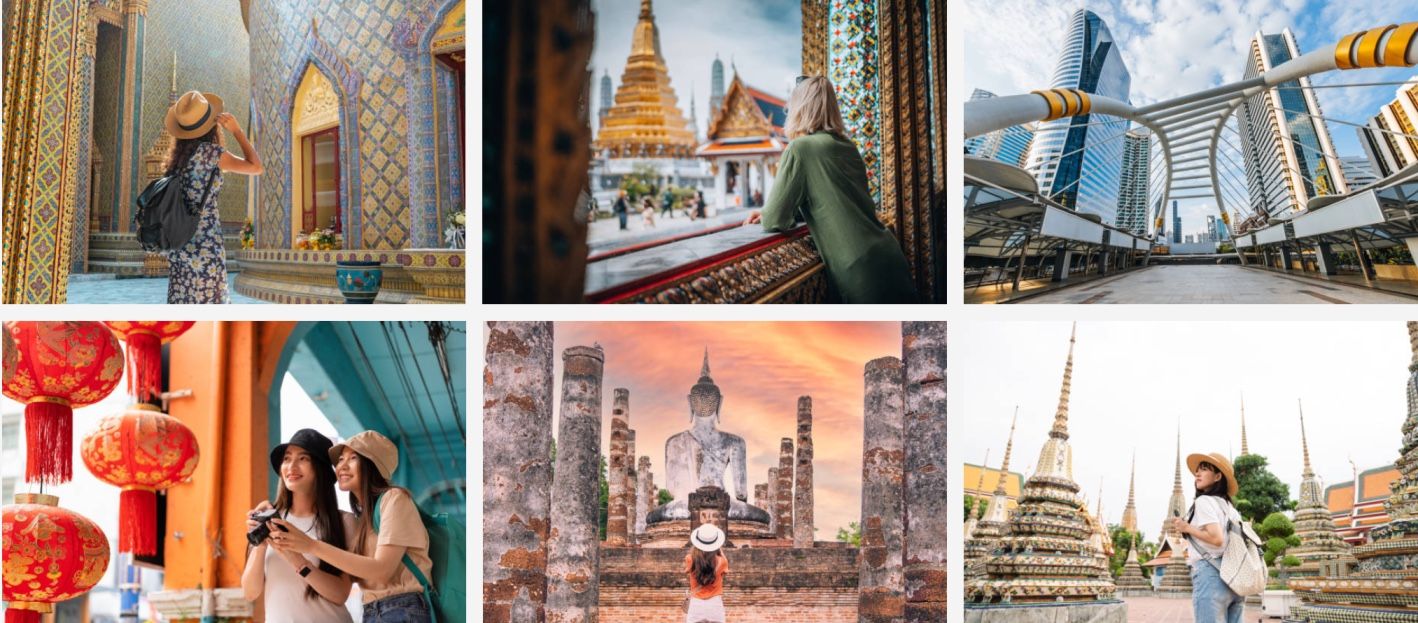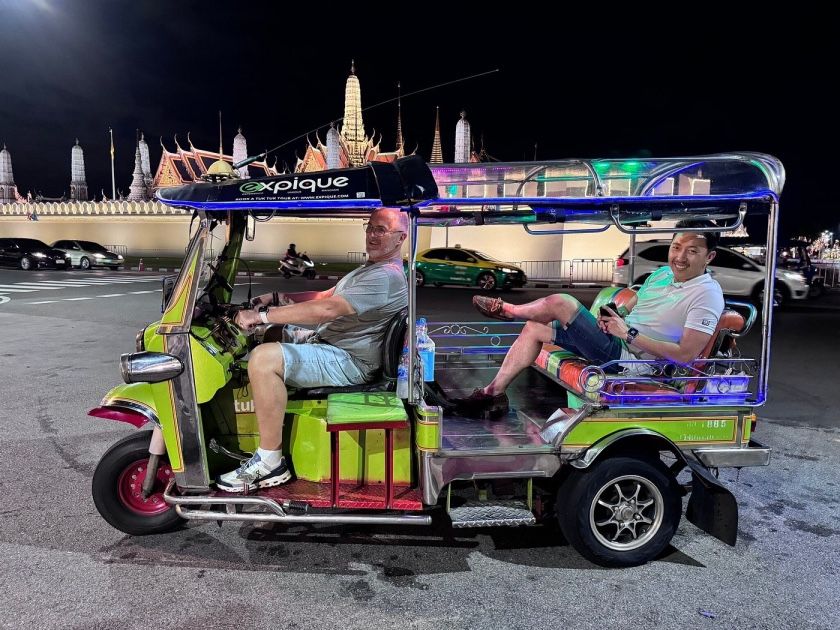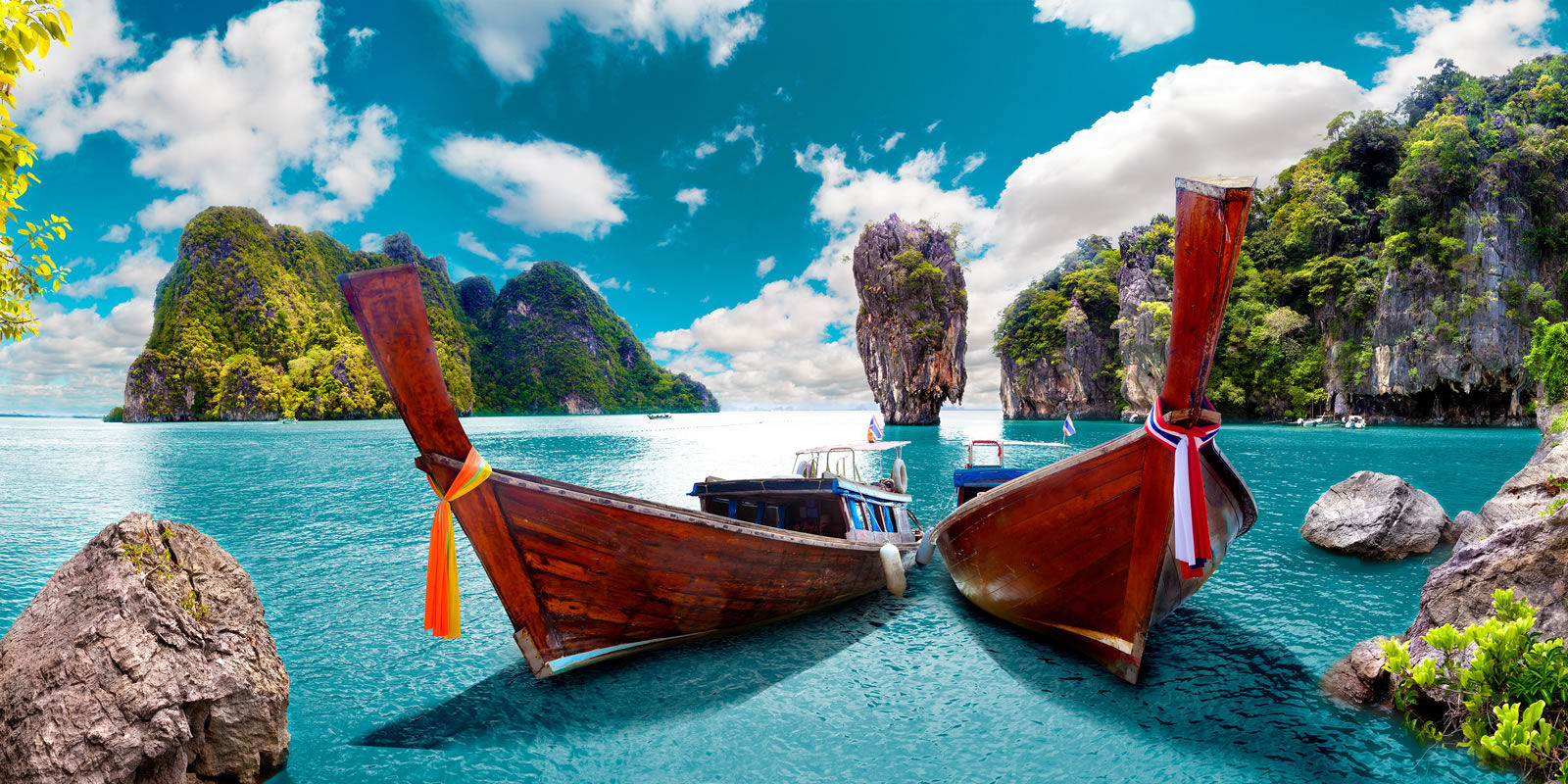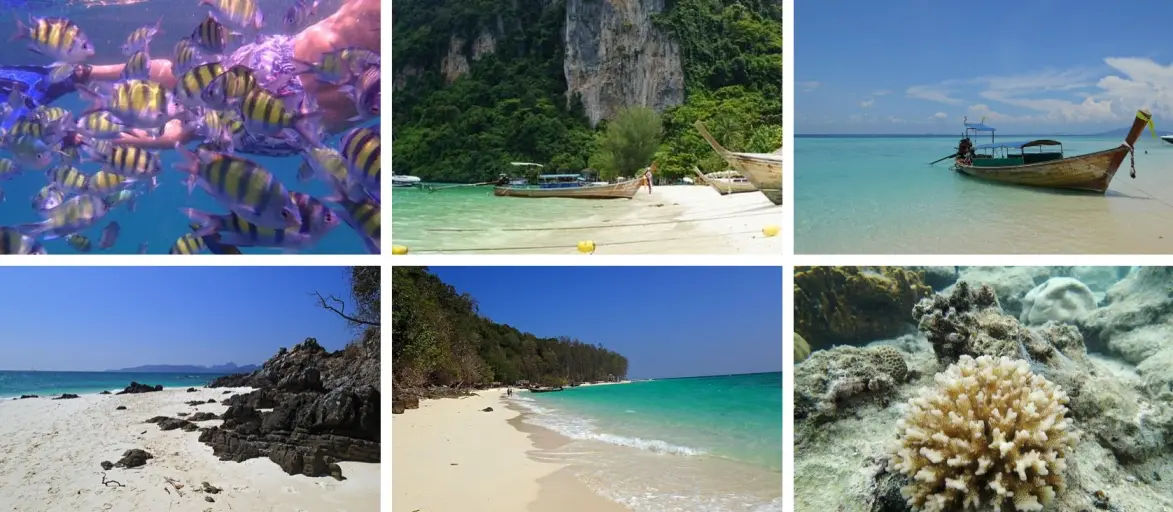Thailand Travel Advice & Tips: Our expert travel advisors have curated about what to do, top attractions to see, and essential tips to help you plan a great trip to Thailand. The Kingdom of Thailand is Southeast Asia’s most-visited destination—and for good reason. It captivates travelers with its stunning natural landscapes, vibrant street life, ancient temples, rich culinary traditions, and warm hospitality. Whether you’re exploring the misty, stupa-dotted mountains of Mae Hong Son, sailing among the dramatic limestone islands of the Andaman Sea, partying in Bangkok’s electric nightlife, or relaxing in the peaceful villages along the Mekong River, Thailand has something to offer every kind of traveler.
Ultimate Guide to Traveling in Thailand
Let’s dive into all the possibilities, travel advices and tips that are being asked by travelers;
Best Time to go – Climate guide
Thailand’s monsoons arrive around July and last into November (the ‘rainy season’). They can be uncomfortably, unpredictably sticky. This is followed by a dry, cool period from November to mid-February, followed by much higher relative temperatures from March to June.
By far the best time to visit is between November and February when the weather is kind and the beaches are at their finest. This period is Thailand’s main season for national and regional festivals.
The peak season is November to late March, with secondary peak months in July and August. If your main objective is to avoid crowds and to take advantage of discounted rooms and low-season rates, you should consider travelling during the least crowded months (April to June, September and October). On the other hand it’s not difficult to leave the crowds behind, even during peak months, if you simply avoid the most popular destinations (eg, Chiang Mai and all islands and beaches). This is also the prime time for diving in terms of visibility and accessibility.
Just The Highlights to visit
Even if you’re just popping into Thailand, you’ll still find plenty of sightseeing options—especially with affordable domestic flights. Since luxury travel in Thailand is booming, start in Bangkok, then head to the tropical breezes of Ko Samui or Phuket. Alternatively, for a more bohemian vibe, hop to Ko Pha-Ngan from Samui or Ko Yao from Phuket.
Thailand’s beach hotspots are quieter—and arguably better—during the low season. However, frequent rain can put a damper on your plans. Generally, the Andaman coast sees more rain than the Gulf side, so be ready to switch coasts if needed. When a multi-day downpour hits, consider Ko Samet or Ko Chang in the Southeastern Gulf, where it typically rains less.
After soaking up the sun, fly to Chiang Mai for a Thai cooking class and temple strolls. Hike to the hilltop temple on Doi Suthep, a popular pilgrimage site. Then, rent a car or motorbike to explore nearby mountains and villages like Chiang Dao and Doi Ang Khang. Finally, before returning to Bangkok to spend your last baht, visit Sukhothai—an ancient capital filled with atmospheric temple ruins.
- Check out thailand Itinerary ideas (1-15-30 days)

What about beaches?
Southern Thailand’s culture reflects centuries of influence from ancient traders from China, India, and Arabia, adding flavor to any beach getaway. For a mix of sun and culture, head to the port town of Surat Thani, the gateway to the Gulf islands: Ko Samui, Ko Pha-Ngan, and Ko Tao. Then, consider a side trip west to Khao Sok National Park, one of Thailand’s most vital rainforests.
Continuing down the Thai-Malay Peninsula, stop in Nakhon Si Thammarat—the cultural heart of the deep south—before visiting Songkhla for fresh seafood and laid-back Thai-style beachcombing. Afterward, cross the peninsula to Satun, where boats depart for the Ko Tarutao Marine National Park.
Along the Andaman coast, the popular beach destinations of Krabi, Ko Phi-Phi, and Phuket line up in a tropical row. However, for more peace and quiet, visit Ko Lanta or Ko Yao. Pay tribute at Khao Lak and Lamru National Park, where massive boulders meet turquoise waters—a place that continues healing after the tsunami. Finally, dive into the underwater wonders of Similan Islands Marine National Park, home to some of Thailand’s top dive sites.
Remote North of Thailand
Misty mountains and diverse hill-tribe villages continue to draw trekkers and cultural travelers to northern Thailand. Start in Chiang Mai, then venture to Chiang Dao for a jungle hike or a walk through its eerie cave system. Next, head to Chiang Rai, where eco-treks connect you with remote hill-tribe communities.
From there, ride to Mae Salong, a mountaintop Yunnanese village. Follow scenic roads along mountain ridges to Doi Tung, once part of the infamous Golden Triangle, and onward to Mae Sai, a bustling border town with Myanmar. Trace the border to Chiang Saen, where boats navigate the Mekong River all the way to China. Then drift downstream to Chiang Khong before looping back to Chiang Rai.
For something more off the beaten path, catch an overnight bus to Nan, a quiet provincial capital surrounded by unique hill-tribe villages found nowhere else in Thailand.
Afterward, head south to Phitsanulok, a laid-back market town and gateway to Thung Salaeng Luang National Park. Continue east to Loei Province for the Dan Sai spirit festival, then push northeast to Chiang Khan, a tranquil riverside village. End your journey in Nong Khai, a charming Mekong town and a popular gateway to Laos, before taking an overnight train back to Bangkok.
Travel advice & tips on money & costs
For buying baht, US dollars are the most readily acceptable currency and travelers cheques get a better rate than cash. British pounds, Euro and generally other major currencies are the next-best option. Credit cards are increasingly acceptable in quality shops, hotels and restaurants. Visa is the most useful, followed by MasterCard.
Money exchange
Banks or legal money-changers offer the best rates. ATMs that accept Visa and other credit cards are widespread throughout Thailand, and many exchange booths will give you a cash advance on your credit card.
Money Tips
Outside Bangkok, budget around ฿1,000–฿1,500 per day for comfortable hotels and restaurant meals. In the capital, expect to spend roughly double that. If budget isn’t a concern, Bangkok offers some of the world’s most luxurious hotels and top-tier shopping experiences. However, once you venture off the beaten path, your spending will naturally decrease due to fewer upscale hotels and fine-dining options.
At markets and street stalls, prices are often negotiable. Thai vendors appreciate a skilled haggler, so always let them make the first offer. Then ask, “Is that your best price?” or “Can you lower it?”—you’ll usually get an immediate discount. Now it’s your turn to counter with a lower offer. Just be sure you’re serious about buying before starting to bargain. Haggling continues until you agree on a price, though discounts vary widely—some vendors start sky-high, while others quote prices closer to fair market value.
- Check out Currency and Money Exchange in Thailand
Tipping in Thailand
Tipping is not generally expected in Thailand. The exception is loose change from a large restaurant bill; if a meal costs ฿488.00 and you pay with a ฿500.00 note, some Thais will leave the change. It’s not so much a tip as a way of saying ‘I’m not so money-grubbing as to grab every last baht’. At many hotel restaurants or other upmarket eateries, a 10% service charge will be added to your bill and tipping is not expected. Bangkok has adopted some standards of tipping, especially in restaurants frequented by foreigners.
Travel tips: Getting around Thailand (Transportation)
Flying to Thailand might be a bit pricey, but once you arrive, you can enjoy incredibly cheap domestic and regional flights—Bangkok ranks among the world’s most affordable cities to fly out of. However, flights in and out of Thailand often get overbooked, so be sure to confirm and reconfirm your reservations.
Thailand shares land borders with Cambodia, Laos, Malaysia, and Myanmar. Thanks to improved highways, overland travel from Thailand to China is also becoming more accessible. Since the early 2000s, plans for land and rail links between China and ASEAN countries, including Thailand, have steadily advanced.
Crossing into Cambodia is usually simple. Most travelers use the Poipet–Aranya Prathet route, which offers the most direct overland connection between Bangkok and Angkor Wat.
To reach Laos, the Thai-Lao Friendship Bridge spans the Mekong River between Nong Khai and Tha Na Leng (near Vientiane), serving as the main transport link between the two countries.
Bus Travel
You can enter Thailand by bus through Laos and Malaysia at the moment – your bus will stop at a Thai immigration post at your point of entry so that each foreign passenger can receive an entry stamp in their passport. Thai visas are not normally included in bus fares. For overland routes through Cambodia, you’ll need to hire a shared taxi. You can exit Thailand into portions of Myanmar by bus or shared taxi.
Boat
All foreign-registered vessels, skippers, and crew must report to Thai authorities immediately after entering Thai waters. While major ports across the country provide check-in services, most leisure boaters check in at Phuket, Krabi, Samui, Pranburi, or Pattaya. Phuket is the most popular port of entry, as Tha Ao Chalong consolidates customs, immigration, and harbourmaster services in one building.
Before leaving Thailand by boat, you must also check out with immigration, customs, and the harbourmaster. Authorities can fine vessels up to ฿5,000 if they depart without proper harbour clearance.
For sea travel between Thailand’s southern peninsula and Malaysia, the easiest route is by boat from Satun to Kuala Perlis or Langkawi Island.
Car
Road passage into Thailand is possible through Malaysia, Cambodia and Laos. Passenger vehicles (eg car, van, truck or motorcycle) can be brought into Thailand for tourist purposes for up to six months. Documents needed for the crossing are a valid International Driving Permit, passport, vehicle registration papers (in the case of a borrowed or hired vehicle, authorisation from the owner) and a cash or bank guarantee equal to the value of the vehicle plus 20%. For entry through Khlong Toey Port or Suvarnabhumi Airport, this means a letter of bank credit; for overland crossings via Malaysia, Cambodia or Laos a ‘self-guarantee’ filled in at the border is sufficient.
Ferry
It’s legal for non-Thais to cross the Mekong River by ferry between Thailand and Laos at the following points: Beung Kan (opposite Paksan), Nakhon Phanom (opposite Tha Khaek), and Chiang Khong (opposite Huay Xai). It is possible to float along the Mekong River from the northern Thai town of Chiang Saen to Jinghong in China’s Yunnan Province.
Bicycle
Many visitors bring their own touring bicycles to Thailand. No special permits are needed for bringing a bicycle into the country, although it may be registered by customs – which means if you don’t leave the country with your bicycle, you’ll have to pay a huge customs duty. It’s essential to bring a well-stocked repair kit and be sure to have your bike serviced before departure.
Train
The only rail option into and out of Thailand is via Malaysia. The State Railway of Thailand (www.railway.co.th) and Malaysian Railway (www.ktmb.com.my) meet at Butterworth, 93km (58mi) south of the Thai-Malaysian border, a transfer point to Penang or Kuala Lumpur. It’s not possible to buy through-fare tickets for rail journeys between Bangkok and Kuala Lumpur or Singapore, unless you ride the luxurious Eastern & Oriental Express, but the trip can be made on express trains via the Thai-Malaysia border at Pedang Besar. The journey usually requires an overnight stop in Butterworth in order to comfortably make train connections.
Plane
While the prices of flights to Thailand are competitive from Australia, New Zealand and Europe, it can be quite expensive flying to Bangkok from other points of departure. The good news is that once you’re in the city you can shop around for an inexpensive return ticket. A host of international carriers land at the new Suvarnabhumi Airport, which has replaced Don Muang as Bangkok’s major airport terminal. Flights in and out of Thailand are often overbooked so it’s imperative that you reconfirm ongoing flights as soon as you arrive. All passengers leaving Thailand on international flights are charged a departure tax, which is not included in the price of air tickets, but paid at a booth near the passport control area. Only baht are accepted. However, the departure tax is slated to be included in ticket prices. The departure tax on international flights is waived if you’re in the country for less than 12 hours.
Motorcycle
Motorcycles can be rented in major towns and tourist centres. Always check the condition of the bike thoroughly before you take off, and remember that the Thais are notorious scoff-laws when it comes to road rules – but, in actual fact, it is reckless tourists who come off motorcycles most frequently, especially in places like Ko Samui and Phuket.
Thailand Travel Experiences
Bangkok is a modern Asian metropolis at its steamy, exhilarating best. Since the late 18th century, it has dominated Thailand’s political, commercial, and cultural life. While the city feels distinctly modern and Westernized, it still holds onto its Thai village roots—just with more traffic and a louder nightlife soundtrack.
Bangkok thrives on the east side of the Mae Nam Chao Phraya (Chao Phraya River), drawing rural Thais into its buzzing sprawl each day. Despite reports that the city is sinking about 5cm (2in) per year, the constant sànùk—a Thai sense of fun—keeps spirits high.
Timing your visit can make a big difference. The best weather falls between November and February, when rain and heat ease up. April is ideal only if you have serious air conditioning. Rain starts around July, and October often brings the heaviest downpours and flooding. Tourist crowds peak in December and August, while May, June, and September tend to be quieter and more relaxed.
Bangkok travel guide
Wake up in Bangkok and know anything is possible. My perfect day starts with a walk through the buzzing streets to find the best egg noodle soup with wontons and red pork—a delicious, everyday dish and perfect hangover cure. Next, I’d hop on a riverboat for a breezy tour of the city’s landmarks without the traffic fumes. A scenic riverside lunch follows—soft-shelled crab with glass noodles at In Love by Thewet pier hits the spot.
Jumping off at Saphan Taksin, I’d ride the Skytrain to Siam for some shopping. Later, a relaxing swim, a Thai massage, and a bag of mangosteens wrap up the afternoon. Bangkok thrives on contrast: pampering and chaos, luxury and grit. That’s why my ideal evening starts with sunset cocktails at Vertigo rooftop bar, followed by spicy salad, sticky rice, red curry squid, and morning glory at a street stall. The car park at Ratchadamri and Soi Sarasin or the Samsen sois in Banglamphu never disappoint.
Meanwhile, another great plan is cold beer and salty beans at the makeshift bars around Chatuchak Weekend Market—a perfect vibe as the stalls wind down. Dinner at an inner-city restaurant adds a nice finish. Furthermore, if the night continues, I’d begin with G&Ts at Cheap Charlie’s on Sukhumvit Soi 11 or enjoy live music at Admakers on Soi Lang Suan, then let Bangkok’s wild energy lead the way. A late-night stroll through Khao San Road, especially as the bars empty into the streets, is always entertaining.
Ko Chang Thailand Travel advice
Ko Chang’s mountainous interior is home to a Jurassic Park of flora and fauna. Ko Chang is bursting with biodiversity: exotic reptiles and technicolour birds are as much a part of the experience as watching sunsets on idyllic beaches. A sandy coast skirts the island revealing postcard-perfect bays. Jungle-encrusted mountains are veiled under a shroud of mist.
Chiang Mai Thailand Travel guide
Chiang Mai blends old-fashioned Thai hospitality with modern city life. Set against a stunning mountain backdrop, this thriving metropolis boasts over 300 temples and a charming historical vibe. Meanwhile, it offers top-quality yet affordable food, accommodation, and shopping—plus cooler nights that add to the appeal.
Founded in 1296, Thailand’s second-largest city serves as the gateway to the north. You can still walk along the old moat that once enclosed the city. Just beyond, Doi Suthep rises above the skyline, crowned by one of Thailand’s holiest temples and offering panoramic views of the city.
- Check out things to do in Chiang Mai
Ko Lanta Travel Thailand
Morning beach strolls, afternoon elephant rides, and partying till the wee hours. Long relegated to the back seat by tourist draws like Phi-Phi and Pha-Ngan, Ko Lanta first became popular with backpackers looking for something a bit different. And while it now has loads of accommodation for pockets of all depths, Ko Lanta remains a friendly, relaxing place to stay.
Ko Phi Phi travel
Scenic hills, awesome limestone cliffs and long, long beaches. Consisting of two islands, Phi-Phi Leh and Phi-Phi Don, Ko Phi-Phi is the Thailand of holiday dreams and tourist brochures. The emerald waters and remarkable sea- and bird-life are sublime, but rampant over-development of Phi-Phi Don threatens to spoil the island’s riches.
Ko Samui Travel guide
Beach paradise central. Party island Ko Samui has long been the locale of choice for paradise-seeking voyagers of all stripes. Its turquoise waters and sun-bleached, sandy bays are lined with multiple bungalows and resorts, a plethora of restaurants to satisfy hungry epicureans, and thumping nightlife providing a soundtrack to the temperate, starry nights. Ko Samui is not everyone’s cup of tea; some revel in its coastal buzz while others cringe at the Khao-San-by-the-beach bustle. But even as the most popular beaches attract the sorts of crowds most people come here to escape, the large island somehow manages to maintain its relaxed atmosphere. Pockets of calm can still be found by those willing to look.
Phuket Thailand Travel
Pearl of the South in the Land of Smiles. Dubbed ‘Pearl of the South’ by the tourist industry, Phuket is Thailand’s largest, most populous and most visited island. A whirl of colour and cosmopolitanism, Thailand’s only island province revolves around and thrives on tourism, but still retains a spark of the real Thailand. There are a hundred and one ways to pass the day in Phuket.
There are also more tourists here than on any other Thai island – it certainly knows how to cater to tourists’ every whim. Most flock to the beaches on the southwestern side, which are loaded with amenities and entertainment options.
Events & celebrations in Thailand
Many Thai festivals follow the lunar calendar and stem from agricultural cycles or Buddhist and Brahman traditions. The most famous, Songkran (Thai New Year), takes place in mid-April. People bathe Buddha images, sprinkle water over elders and monks, and soak each other in joyful water fights—expect to get drenched unless you hide indoors.
Rice sowing and harvesting inspire several festivals. In June, the king kicks off the planting season with a Brahman ritual at Sanam Luang in Bangkok. Also in June, the Rocket Festival in the northeast features bamboo-and-gunpowder rockets meant to summon rain. From September to May, harvest celebrations spread across the country.
During late September to early October, Phuket and Trang host the Vegetarian Festival, where Chinese Buddhists eat only plant-based food for nine days. Merit-making processions and temple ceremonies mark this spiritually charged event.
In November, Surin stages the Elephant Roundup, ideal for anyone who enjoys watching elephants perform. That same month, the Loi Krathong Festival lights up rivers and lakes with candle-lit floats, believed to bring good fortune. Chiang Mai and Bangkok offer especially atmospheric celebrations.
That Phanom Festival
A 10-day homage to the northeast’s most sacred Buddhist stupa (Phra That Phanom) in Nakhon Phanom Province of Thailand. Pilgrims from all over the country, as well as from Laos, attend.
Bangkok International Film Festival
Films from around the world, with an emphasis on Asian cinema, are screened in the capital. Events end with the awarding of the festival’s Golden Kinnaree in a range of categories.
Chiang Mai Flower Festival
Held in JAN/ FEB, Colourful floats and parades exhibit Chiang Mai’s cultivated flora.
Phra Nakhon Khiri Diamond Festival
One of the most celebrated festivals in Thailand. This week-long celebration of Phetchaburi’s history and architecture focuses on Phra Nakhon Khiri Historical Park, a hill topped by a former royal palace overlooking the city. It features a sound-and-light show and presentations of Thai classical dance-drama.
Chinese New Year in Thailand
Called trùt jiin in Thai, Chinese all over Thailand celebrate their lunar New Year with a week of house-cleaning, lion dances and fireworks. Also, this festival is one of the most celebrated in the region.
- Read more about Vietnamese Lunar New year
Magha Puja
Held on the full moon of the third lunar month to commemorate Buddha preaching to 1250 enlightened monks who came to hear him ‘without prior summons’. A public holiday throughout the country, it culminates with a candle-lit walk around the wian thian(main chapel) at every wat.
Bottom line: Travel Advices for Thailand
Thailand ranks among the world’s top tourist destinations, but smart preparation ensures a safe, well planned and enjoyable trip. Stay alert in crowded areas to protect yourself from petty theft and scams. Additionally, get all recommended vaccinations, purchase comprehensive travel insurance, and learn basic Thai customs and etiquette to show respect and avoid cultural missteps.





You May Also Like
Long Coc Tea Hills in Phu Tho: A Hidden Photography Spot Near Hanoi
Long Coc Tea Hills in Phu Tho is a breathtaking hidden gem in northern Vietnam, ...
The Ultimate Guide For Visiting Visit Vietnam In February: Weather, Festivals & Itineraries
Imagine walking through Hanoi’s Old Quarter as peach blossoms bloom in doorways, or sitting by ...
Toilets in Vietnam: A Traveler’s Guide for Squat Toilets, Public Bathrooms & Flushing Paper
Let’s be honest—when you travel, toilets matter more than you expect. In Vietnam, they quickly ...
20 Traditional Vietnamese Folk Games
Traditional folk games in Vietnam are more than just childhood pastimes. They are the living, ...
How to Register a Company in Vietnam (2026 Guide)
Foreign investors planning to do business in Vietnam face a multifaceted legal system and bureaucratic ...
Visiting Vietnam in January 2026: Weather, Costs, Festivals & Travel Tips
I visited Vietnam in January 2026, and I still remember the crisp, cool air in ...